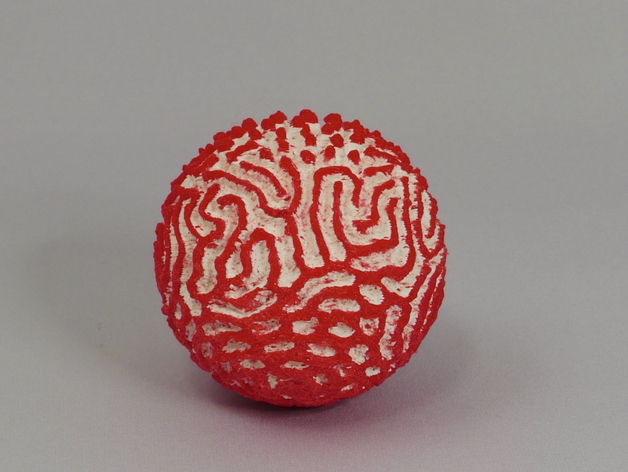
Reaction-Diffusion Ball
thingiverse
My experimentation with a reaction-diffusion model. The reaction-diffusion system is designed to generate intricate patterns on animal surfaces such as zebra stripes or fish scales. Check out this detailed explanation at http://www.karlsims.com/rd.html . Calculated world within a sphere using a C program, crafting an OpenSCAD subroutine that functions almost identically to the original C code. Printer Settings Da Vinci 2.0 Duo is used for printing, equipped with features such as Rafts and Supports. Notes: Adjust reaction-diffusion patterns by modifying parameters in "rdball2.c", compiling, and running, redirecting output to "rdball-sub.scad". The generated OpenSCAD subroutine draws a single polyhedron. I combined two different designs using boolean operations with Blender for inner.stl and outer.stl files. How This Design Came Together The algorithm is based on the Gray-Scott model in a three-dimensional space, simulating a sphere by inscribing an octahedron that is projected onto the surface of the sphere. Calculations are made by Dr. Ide of Kanagawa University, utilizing a network of interconnected nodes and applying the Laplacian operator. Both .stl files generated (constant and variable parameters) were achieved with initial values INITK1 and INITK2 set in the C program, demonstrating its versatility. The algorithm takes coordinates of each node ("points" of polyhedron() in OpenSCAD), along with relationships between them ("faces"), to create an OpenSCAD module from which the model is derived – all handled seamlessly by the C code itself!
With this file you will be able to print Reaction-Diffusion Ball with your 3D printer. Click on the button and save the file on your computer to work, edit or customize your design. You can also find more 3D designs for printers on Reaction-Diffusion Ball.
